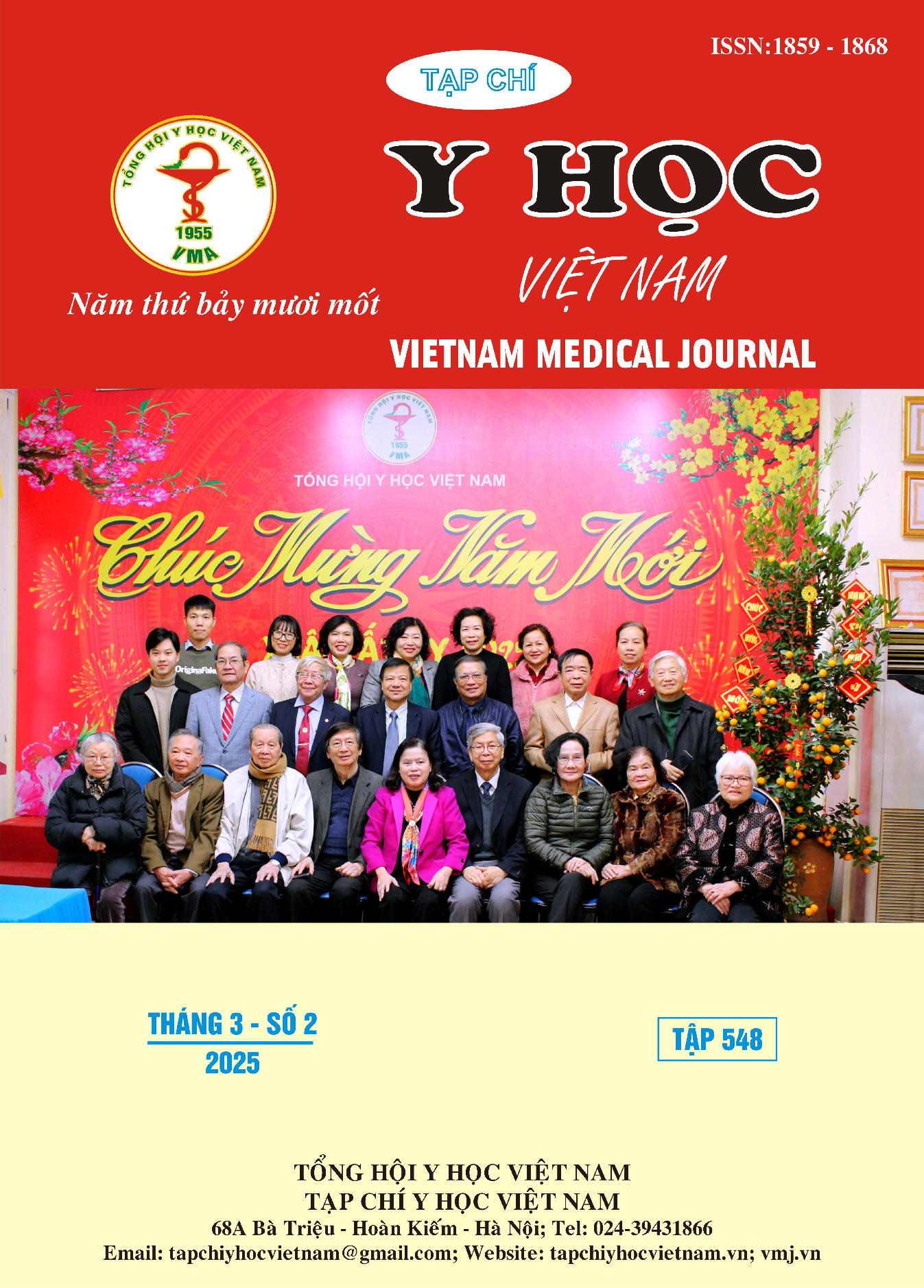ANASTOMOTIC LEAKAGE AFTER LAPAROSCOPIC AND THORACOSCOPIC WHOLE-STOMACH ESOPHAGECTOMY WITH PREOPERATIVE PYLORIC BALLOON DILATATION FOR ESOPHAGEAL SQUAMOUS CELL CARCINOMA
Main Article Content
Abstract
Objectives: Analysis of risk factors for postoperative anastomosis leak anastomotic in a group of patients undergoing laparoscopic and thoracoscopic whole stomach esophagectomy with preoperative pyloric balloon dilatation for esophageal squamous cell carcinoma. Subjects and methods: A retrospective descriptive study on 28 patients undergoing laparoscopic and thoracoscopic whole stomach esophagectomy with preoperative pyloric balloon dilatation at Ha Noi Medical University and Viet Duc Medical University from January 2020 to March 2023. Results: We performed laparoscopic and thoracoscopic whole stomach esophagectomy with preoperative pyloric balloon dilatation for 37 patients. The mean age was 57.1 ± 8.68. All patients were male. The mean surgical time was 305.9 ± 46.95 minutes. The conversion rate to open abdominal surgery was 2 patients (5.4%), the rate of end-to-end anastomosis was 94.6%. The mean duration of mechanical ventilation was 32.3 ± 28.42 minutes, the time to remove the pleural drain was 9.1 ± 5.76 days, and the mean of hospital stay was 13.6 ± 6.28 days. Among 34 post-operative cases underwent gastric transit scans, most had non-dilated stomachs with efficient pyloric drug circulation (82.4%). The rate of anastomotic leakage in 2 patients (5.4%), pneumonia in 3 patients (8.1%), chylothorax in 4 patients (10.8%) and recurrent laryngeal nerve damage occurred in 10.8% of cases. In the 2 patients with anastomotic leakage, 1 patient had a history of cardiovascular disease. Both patients had preoperative normal nutritional status. After surgery, both cases showed signs of anastomotic stenosis. There was a patient who had esophageal dilation with a balloon and the other had esophageal stent. Conclusion: laparoscopic and thoracoscopic whole stomach esophagectomy with preoperative pyloric balloon is safe and feasible with a low rate of anastomotic leakage and other complications. However, this is a difficult technique, requiring the surgeon to have a lot of experience and adequate equipment and instruments.
Article Details
Keywords
laparoscopic and thoracoscopic esophagectomy, esophageal squamous cell.
References
2. Famiglietti A, Lazar JF, Henderson H, et al. Management of anastomotic leaks after esophagectomy and gastric pull-up. J Thorac Dis. 2020;12(3):1022-1030. doi:10.21037/jtd.2020.01.15
3. Biere SSAY, Maas KW, Cuesta MA, van der Peet DL. Cervical or Thoracic Anastomosis after Esophagectomy for Cancer: A Systematic Review and Meta-Analysis. Digestive Surgery. 2011;28(1):29-35. doi:10.1159/000322014
4. Ubels S, Verstegen MHP, Rosman C, Reynolds JV. Anastomotic leakage after esophagectomy for esophageal cancer: risk factors and operative treatment. Annals of Esophagus. 2021;4(0). doi:10.21037/aoe-2020-18
5. Manghelli JL, Ceppa DP, Greenberg JW, et al. Management of anastomotic leaks following esophagectomy: when to intervene? J Thorac Dis. 2019;11(1):131-137. doi:10.21037/jtd.2018.12.13
6. Li H, Zhuang S, Yan H, Wei W, Su Q. Risk Factors of Anastomotic Leakage After Esophagectomy With Intrathoracic Anastomosis. Front Surg. 2021;8. doi:10.3389/fsurg. 2021.743266
7. Fabbi M, Hagens ERC, van Berge Henegouwen MI, Gisbertz SS. Anastomotic leakage after esophagectomy for esophageal cancer: definitions, diagnostics, and treatment. Dis Esophagus. 2021;34(1):doaa039. doi:10. 1093/dote/doaa039
8. Goense L, Rossum PSN van, Ruurda JP, et al. Radiation to the Gastric Fundus Increases the Risk of Anastomotic Leakage After Esophagectomy. The Annals of Thoracic Surgery. 2016; 102(6): 1798-1804. doi:10.1016/j. athoracsur.2016.08.027
9. Markar SR, Arya S, Karthikesalingam A, Hanna GB. Technical Factors that Affect Anastomotic Integrity Following Esophagectomy: Systematic Review and Meta-analysis. Ann Surg Oncol. 2013;20(13): 4274-4281. doi:10.1245/ s10434-013-3189-x
10. Lv L, Hu W, Ren Y, Wei X. Minimally invasive esophagectomy versus open esophagectomy for esophageal cancer: a meta-analysis. Onco Targets Ther. 2016;9:6751-6762. doi:10.2147/ OTT.S112105


